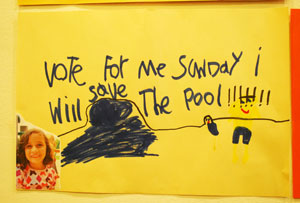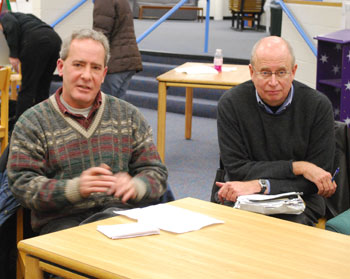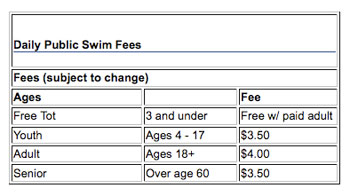Task Force Floats Ways to Save Mack Pool
There aren’t many meetings you can attend where some of the pre-meeting conversation goes like this: “I didn’t recognize you with your clothes on!”

Keeping Mack Pool open is even a campaign issue for student council, based on this sign in the hallway. The election is scheduled for Friday, Nov. 13.
Swimmers can get away with that kind of banter, and swimmers of all sorts showed up Thursday night to talk about what the city should do to keep Mack Pool open. The public meeting was held at the media center of the Open School @ Mack, just down the hall from the pool – but far enough away to smell only the faintest whiff of chlorine.
Closing Mack Pool, or turning it over to the Ann Arbor school system, was one of the options proposed by city administrator Roger Fraser at an April 13, 2009 council working session, as a way to help balance the city’s budget in the face of declining revenues projected for 2010 and 2011. There’s about a $100,000 shortfall between what it costs to run the pool each year and the revenues it takes in. Figuring out how to make up that difference is the goal of the Mack Pool Task Force, which hosted Thursday’s meeting.
Response to the Threat of Closing
After getting news that Mack Pool might be closed in the summer of 2010, supporters had quickly mobilized, as did users of the Ann Arbor Senior Center, which is the other parks and recreation facility that had been slated to close. Members of the Dawn Ducks and master’s swimming – two groups that regularly use the indoor pool – were particularly vocal.
This summer, the city formed task forces for both Mack Pool and the senior center, and gave them the goal of coming up with recommendations that would allow the city to keep the facilities open. Public meetings for the Ann Arbor Senior Center were held in October. [See Chronicle coverage: "Seniors Weigh In On Fate of Center"] Thursday’s meeting for Mack Pool followed a similar format. After an overview of the situation, presented by Colin Smith – the city’s parks and recreation services manager, who also serves on the task force – the gathering broke into three small groups for discussion.

Scott Rosencrans, left, and Ed Sketch are both members of the Mack Pool Task Force. Rosencrans is chair of the Ann Arbor Park Advisory Commission. Sketch is coordinator for the Mack Pool users group. (Photo by the writer.)
Several members of the Mack Pool Task Force, appointed by city council in August 2009, attended the session, including Scott Rosencrans, chair of the city’s Park Advisory Commission; Nell Stern, a member of the Dawn Ducks; Ed Sketch, coordinator of the Mack Pool users group; Chris Murphy, whose daughter is part of the Ann Arbor Aquarians Synchronized Swim Team, which trains at the pool; and Carsten Hohnke, a city councilmember for Ward 5, where Mack Pool is located.
Other politicians attended too, including city councilmember Mike Anglin (Ward 5) and Mayor John Hieftje. Hieftje gave some opening remarks to the group, reminding them that Ann Arbor was not alone in facing financial challenges. Lower amounts from state revenue-sharing as well as a decrease in local property taxes have caused cities across Michigan to suffer, he said. Ann Arbor is in better shape than most, but still needs help from the public to deal with the situation.
Colin Smith told the group that the task force has formed three subcommittees, focused on revenues, expenses and city/school use. Though the pool is owned by the city, Ann Arbor Public Schools has an agreement – in perpetuity – for use of the pool during school hours. That limits the amount of programming the city can schedule, and AAPS has agreed to renegotiate the agreement to reflect current realities, Smith said. [The principal of the Open School @ Mack, Naomi Zikmund-Fisher, is on the pool task force but did not attend Thursday's meeting.] A draft of the new agreement is expected by late December or early January.
Raising Revenues, Cutting Costs
On the expense side, Smith said the bad news is that there’s no silver bullet. Over the past decade, the city has cut costs at Mack down to the bare bones, he said. The subcommittee that’s looking at expenses went over the budget line item by line item, and weren’t able to find significant places to cut.
Energy costs are a huge expense, Smith said, required to heat the pool and run equipment. An energy audit was conducted to see if there were significant ways to improve efficiency, and there weren’t. The city has applied for a grant to get LED lights installed in the pool deck, but that will only save about $2,000 to $3,000 annually, he said.
More opportunities come from possible revenue growth, Smith said. Most of the ideas discussed on Thursday fell into that category, and many of the suggestions focused on increasing the number of people who use the pool. The following is a list of suggestions that were voiced during the meeting:
- Offer more classes: Water aerobics, scuba, kayaking, and more. Partner with local gyms or places such as the VA hospital, which provides therapy and programs like kayaking courses for disabled veterans.
- Do a better job of marketing the pool. Put fliers in doctors’ offices, offer coupons, advertise with University of Michigan programs like MFit.
- Hold fundraisers and donor drives. Partner with the University of Michigan to raffle off time with their swimming coaches.
- Expand the number of morning hours available, as well as the “lunch swim,” which currently runs only from 11 a.m. until noon. Extend the lunch swim hours until 1 p.m. or later. (This would be contingent on renegotiating an agreement with the school system.)

Chart of fees for daily use of Mack Pool. Some people at Thursday evening’s meeting suggested that fees be raised.
- Increase user fees. Some believe that fees for master’s swimming could be doubled, for example. Currently, passes for a two-month master’s swimming session, five days a week, costs $105 for city residents, $128 for non-residents. Other categories of fees could be raised as well.
- Caution came with the discussion of raising fees – it’s also important to keep the facility accessible to all groups, regardless of income. Perhaps that can be handled via scholarships, some said. Others suggested outreach to residents at nearby Miller Manor, a public housing complex. Grants to fund programs for underprivileged populations might help with that.
- Offer a greater variety of passes. Currently, you can pay a daily fee or get a pass for the entire season. In addition, offer passes for shorter periods, like one to three months.
- Provide food and other amenities to purchase.
- Provide more pool toys.
- As much as possible, make sure at least some lanes are open for lap swims.
- Solicit school groups and clubs to rent the pool for parties.
- Provide child care for parents who want to do lap swims.
- Start a grassroots marketing effort, using yard signs and word of mouth, to promote Mack Pool as a “hidden gem.”
- Save chemical costs by using an ionizing process rather than chlorine. Market the pool as chlorine-free.
- Invest in variable frequency drives for the pool pumping system, to reduce energy costs.
- Buy a “pool blanket” to place over the top of the pool when it’s not in use, preserving heat.
- Start a public swim team for kids, similar to ones that are active during the summer at the outdoor pools.
- Invest in a geothermal system to heat the pool. Hieftje said that the city is looking at partnering with a company to install a large geothermal heating system in the downtown area, which perhaps could be extended to Mack Pool. He said the city’s energy commission, on which he serves, would explore the possibility.

Dan McGuire, right, is supervisor of Mack and Fuller pools for Ann Arbor parks and recreation. (Photo by the writer.)
There was also some discussion of the pool temperature, which is currently set at 82 degrees. Preferences differ among the user groups, with master’s swimmers preferring a cooler water temperature, and others wanting it warmer. One suggestion centered on dividing the pool into two sections, and maintaining different water temperatures in each section. However, Smith noted that the water source is the same for the entire pool, and could not provide variable temperatures.
Ed Sketch, a task force member, noted that at this point it was difficult to convince the city to invest in Mack Pool. Why would you want to do that, if it’s possibly going to close? he said. “In a sense, we’ve got to crack the business model first,” he said. “Once you’re over that hump, a whole lot of things become possible.”
Timeline for Recommendations
Colin Smith told the group that the city planned another public meeting on Dec. 10, 2009 to present a draft of recommendations and get feedback. Those recommendations would then be presented to the city’s Park Advisory Commission at their meeting on Jan. 19, 2010. PAC would vote on the recommendations, which would be forwarded to city council.
Council is expected to consider the recommendations in February, and make a final decision on the overall 2011 budget in May. Between now and then, “we have a lot to do,” Smith said. “We have a lot to do quickly.”







I am not a swimmer so I am not aware of what other indoor pool options, other than the YMCA, are available to Ann Arbor residents. Has this been evaluated as part of this process? There are other pools in schools (I know of Slauson, Pioneer and Huron). Are they also owned by the city or are they owned by the schools? If the latter, could the schools provide open hours for public swims at a lower cost?
If Mack pool tries to raise revenue by offering more swim classes, etc., who is their competition and is there enough local demand to make it profitable for the Mack pool?
Regardless of who it’s owned by (school board or city), and I assume it’s school board, it should be opened to the public since it’s funded by tax dollars (outside school hours of course).
The article above states the pool is owned by the city and that the school has an never-ending agreement to use the pool for school activities. That is an interesting arrangement. I was wondering if the same ownership/arrangement is at place with the other school pools.
Re. use of a city-owned pool by the schools: Mack Pool is the only pool with this arrangement.
Get rid of that so-called-art boondoggle from in front of the new-city-hall boondoggle and there will be plenty of dough for both the pool and the seniors! And while we’re at it, don’t forget to vote-out the politicos who enabled this situation in the first place! Let’s get our priorities straight, folks!
Mary, thanks for the clarification. It appears to be too simple a solution, but if the city closed Mack Pool to public access could the other schools open up theirs? The schools are already paying for pool upkeep so I would not imagine allowing public access would significantly increase those fees. Income from access fees should be able to cover any cost increases.
David #6, the problem with your solution is that all of the other school pools are in middle and high schools, and are used for instruction throughout the day. There are too many liabilities obviously to have unvetted adults mixing with unaccompanied children in locker rooms, not to mention the scheduling problems.
Mack is the only elementary school in town with a pool. The pool was originally built to be for community use, like Vet’s and Fuller, and the only one with year round capability. The kids got to use it because it was there, but it was never intended that way. Out of fairness to all of the other elementary school children in town, they really should not be using it.
The problem is with adults near school grounds during the day, otherwise it should be open to community groups and individuals just like a pool at the Y or a private facility.
FYI, Mack School is not just an elementary school. It is also a middle school. It’s K-8.
Cosmo #7, one could then consider early morning (before school starts), late afternoon/evening hours (once all school activities are over) and weekends (when there is no school).
David #9, I suppose so, but aren’t those the public hours now? I don’t know.
Merely tried to put some perspective on how we got here from my recollections. I have no opinion on how to resolve this, though when the facility was built the school was K-6, and it probably made sense at the time. If the only kids allowed in were 7th and 8th graders so the curriculum matched the other schools, and they were there at specific hours, with sufficient security arrangements I don’t see why more time during the school day couldn’t be alloted to other groups.
Time sharing is only one of the problems at that pool as stated in the article. Lack of use is noted as well as a need to enhance revenue, at a glance the rates seem too low, perhaps lap swimmers could rent lanes by the hour.
There’s nothing wrong with seeking ways to make small neighborhood civic programs more financially efficient. Still, Rob [#5] is correct in that the money to continue funding the pool (and the senior center) is still out there, while city council has now become less than willing to allocate it, preferring to let programs like this sink and drown. A valiant rescue operation by concerned volunteer citizens should be unnecessary.
The proposed city hall sculpture represents a one-time expense of almost $1 million. Savings from its cancellation, while helpful for a few years, cannot indefinitely be carried into the future. However, it’s entirely fair to insist that the One Percent for Art fund — the ongoing “pool” of city money which is supposed to underwrite the sculpture — can regularly be “pirated” in the years ahead to support smaller, worthwhile community programs. Let’s restructure the OPFA fund and expand its funding targets in the city budget to include services, so as to make these line items seaworthy again.
As for voting out the current crop of politicians, keep in mind that some aspiring, would-be council people bring an agenda — such as a full downtown greenway — that also places services like the Mack pool or the Burns Park senior center in lower priority to a greater civic ambition.
On the lighter side, the whale offered the perfect backdrop for the Mach Pool discussion.
I have enjoyed swimming at Mack Pool for years. The staff are pleasant and the pool is not over-crowded. Mack Pool is accessible to people in the community who do not have enough money to join the YMCA.
Re: different types of swim passes — I would love to buy a 20-swim ticket pack, or something like that. Once I have the passes, I’m more likely to swim. It would be less expensive than a full year pass, and would fit my family’s needs.
Did I miss something, or did I see that no one mentioned contacting local swim clubs to see if they are interested in renting the pool for practice time? Also, I’m told that the air quality in the pool area is pretty bad, which prohibits some from using it. Any mention of that?
Ionization is a simple way to save thousands of dollars per year in chlorine costs, while making the pool more pleasant to swim in. However, as state at the main meeting, the pool would still have to use about a third of the chlorine previously used so it would not be chlorine free, just 2/3 reduced. The A2 Chronicle article did not mention that Replacing the current pumps with VFD (variable frequency pumps) would save lots of energy; and are eligible for large rebates from DTE’s largely hidden, but available, generous rebate program.
Johnson Controls did the earlier energy audit of the pool, They typically look at things that will make them lots of money, rather than what is cost effective for the client. The fact that they didn’t mention ionization, pool blankets, Energy efficient (VFD) pumps that run 24 hours/day, alcohol based evaporation suppressants, and many other cost effective measures is telling. These things all pay back in one year in savings and cost little, so Johnson controls can’t really make any money on them.